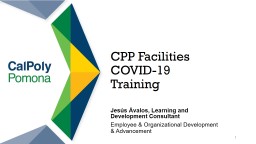

Jesús Ávalos Learning and Development Consultant Employee amp Organizational Development amp Advancement 1 Thank you The work you do is critical to the success of the university and our health as a community ID: 1001100
Download Presentation The PPT/PDF document "CPP Facilities COVID-19 Training" is the property of its rightful owner. Permission is granted to download and print the materials on this web site for personal, non-commercial use only, and to display it on your personal computer provided you do not modify the materials and that you retain all copyright notices contained in the materials. By downloading content from our website, you accept the terms of this agreement.
1. CPP Facilities COVID-19 TrainingJesús Ávalos, Learning and Development ConsultantEmployee & Organizational Development & Advancement1
2. Thank you! The work you do is critical to the success of the university and our health as a community. This Photo by Unknown Author is licensed under CC BY-NC
3. General InformationBased on guidance from the CDC and the CA Dept of Public HealthContinue to employ your current best practicesFeel free to ask any questions via chat
4. ObjectivesLearn how to create a safe environment for our faculty, staff, and students to work and learnLearn how to do your work in a way that keeps you healthy and safe4
5. AgendaKeeping Yourself SafeProper Cleaning Procedures
6. Keeping Yourself Safe6
7. COVID-19: Know How It spreadsCurrently no vaccine The best way to prevent illness is to avoid being exposed to the virusSpread mainly from person-to-person.People who are in close contact (within about 6 feet).Through respiratory droplets from coughs or sneezes.These droplets can be inhaledCan also be spread by touching contaminated surfaces and then touching mouth, eyes, or nose
8. Steps to Protect Yourself (and others)Clean your hands oftenWash your hands often with soap and water (for at least 20 seconds) Use a hand sanitizer that contains at least 60% alcohol. Avoid touching your eyes, nose, and mouthIf hands are visibly dirty, rinse off the dirt before using a sanitizer.
9. Steps to Protect Yourself (and others)https://www.youtube.com/watch?v=seA1wbXUQTs
10. Steps to Protect Yourself (and others)Wear a facemaskAt all times unless you are working in your office with the door closed
11. Steps to Protect Yourself (and others)6-foot Rule: Physical Distancing Keep space between yourself and others, whenever possibleEspecially those who are sickAvoid gathering with others, particularly indoors
12. Steps to Protect Yourself (and others)Stay home if you are sickAvoid densely populated public areasAvoid public transportation: Avoid using public transportation, ride-sharing, or taxis.
13. Steps to Protect Yourself (and others)Cover your mouth and nose with a tissue when you cough or sneeze or use the inside of your elbow.Throw used tissues in the trash.Immediately wash your hands with soap and water for at least 20 seconds. If soap and water are not readily available, clean your hands with a hand sanitizer that contains at least 60% alcohol.
14. Caring for YourselfSymptoms of COVID-19FeverCoughShortness of breachLoss of taste or smellIf you feel you may be sickDo not report to workImmediately call your health care providerAdvise your HEERA manager
15. Proper Cleaning ProceduresAdditional text or subhed goes here and here15
16. Personal Protective Equipment (PPE)Wear disposable gloves and University issued equipment, as appropriate for all tasks in the cleaning process, such as handling trash. Gloves should be compatible with the disinfectant products being used.Additional PPE, such as goggles might be required based on the cleaning/disinfectant products being used and the risk of splashing the product.Report breaches in PPE (e.g., tear in gloves) or any potential exposures to your supervisor right away.
17. How to Properly Remove Gloves
18. Cleaning, Sanitizing, and DisinfectingCleaning removes dust, dirt and impurities from surfaces or objects.Sanitizing lowers the number of germs on surfaces or objects to a safe level, as judged by public health standards or requirements. Disinfecting kills germs on surfaces or objects
19. How to Clean and DisinfectClean AND disinfect frequently touched surfaces daily. This includes tables, doorknobs, light switches, counters, handles, desks, phones, hand rails, elevator buttons, toilets, faucets, and sinks.If surfaces are dirty, clean them: Use detergent or soap and water prior to disinfection.
20. How to Clean and DisinfectNon-porous surfaces (such as metals and plastics) If surfaces are dirty, remove the excess dirt by sweeping or wiping it off BEFORE cleaning. Disinfectants can’t do their job if the surface is dirty.For disinfection, only use approved CPP cleaning/disinfectant products. For an approved list of products see your supervisorFollow manufacturer’s instructions for application for all cleaning and disinfection products (e.g., concentration, application method and contact time, etc.) and proper ventilation.Check to ensure the product is not past its expiration date.
21. How to Clean and DisinfectPorous surfaces (such as fabrics or carpets)For surfaces such as carpets, remove visible contamination if present and clean with appropriate cleaners indicated for use on these surfaces.If disinfection is required, apply the disinfectant and let it sit for the time specified on the label.
22. How to Clean and DisinfectClothing and Other Items that go in the LaundryDo not shake dirty laundry; this minimize the possibility of dispersing virus through the air.
23. Student Housing CustodialAt a facility that does house people overnight:It is recommended to close off areas used by persons and wait as long as practical before beginning cleaning and disinfection to minimize potential for exposure to respiratory droplets.Open outside doors and windows to increase air circulation in the area.Focusing on cleaning and disinfecting common areas where staff/others providing services may come into contact with ill persons, but reducing cleaning and disinfection of bedrooms/bathrooms used by ill persons to as needed.In areas where ill persons have visited or used, continue routine cleaning and disinfection as in this guidance.
24. SummaryPractice physical distancing and be sure to wash your hands fully and frequentlyUse your PPE consistently and correctlyClean and disinfect all high touch surfaces every day
25. Final Questions/Comments25